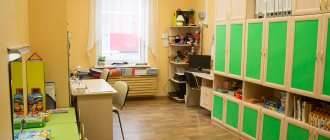Project “We speak beautifully”
Table of contents
| Section I: Information part of the project |
| Section II: Content of the project |
| 1. Project summary 2. The relevance of the topic and the problem that the project is aimed at solving 3. Project goals and objectives 4. Possible risks and ways to overcome them 5. Planning work to implement the project 6. Image of the final result, criteria for its evaluation 7. Project resource support 8. Project development prospects |
| Section III: Project Budget |
| Literature |
| Applications |
Section I: Information part
Project passport
| Project name: | "We speak beautifully" |
| Project type: | Long-term, practice-oriented |
| Name of institution | MBDOU "Kindergarten No. 317", Perm |
| Institution address | |
| Institution telephone, fax | |
| OU email address | [email protected] |
| Full name of the head of the educational institution | |
| Project Manager | |
| Project duration | August 2012 – May 3013 (interim) |
Section II: Content of the project
1. Project summary
A modern preschool educational institution is a kindergarten that has the opportunity to develop sustainably and draw up a program of correctional and developmental work in accordance with the needs of preschoolers and the requests of parents.
This project is aimed at providing correctional and developmental speech therapy assistance to children and their parents (legal representatives) interested in the development of the child. The project is designed for children from 3 to 5 years old attending preschool. It allows you to relieve tension and ensure the availability of speech therapy assistance during the sensitive period of development and speech formation of preschool children in the conditions of a speech therapy center at a preschool educational institution.
The project “We speak beautifully” is open in nature: having studied the requests of parents of children attending primary and secondary groups of kindergarten based on the results of a survey, it was decided to introduce and invite interested parents to attend speech therapy classes with their children, which will provide pedagogical assistance and increase the competence of parents. Thus, individualization of the speech therapy assistance provided is achieved at the specific request of parents and a specific child with speech underdevelopment, and an individual route is developed aimed at correcting speech pathology.
The project will be implemented through various forms of organizing the provision of services:
1. Collective based at the preschool educational institution (parent meetings, club)
2. Individual on the basis of a preschool educational institution in the correction room, by appointment).
This project is expected to be implemented in four stages:
Stage I - preparatory: September - October 2012.
Stage II – organizational and design: November 2012 – February 2013.
Stage III – practical: 02/11/2013 – 05/30/2013
Stage IV – analytical: September 2013.
2. The relevance of the topic and the problem that the project is aimed at solving.
“The strategic goal of state policy in the field of education is to increase the availability of quality education that meets the modern needs of society and every citizen (Concept of the Federal Target Program for the Development of Education for 2011-2015, approved by Decree of the Government of the Russian Federation dated February 7, 2011 N 163-r) . All this implies comprehensive satisfaction of the population’s needs for educational services, improving the quality of preschool education, and searching for effective forms of organizing the activities of preschool institutions.
The regulatory framework and regulations on the speech therapy center of a preschool educational institution make it possible to reconsider the priorities of providing speech therapy assistance and involving parents, which will contribute to more effective and high-quality work of a speech therapist with children under 5 years old in the conditions of a speech therapy center of a preschool educational institution.
To assess the capabilities of this work, MBDOU “Kindergarten No. 317” in Perm, various studies were carried out, summarizing the results of which the following conclusions can be drawn:
1. Parents of younger preschoolers are interested in improving the quality of their children’s speech.
2. The preschool educational institution has sufficient resources in the form of human resources (teacher-speech therapist (1.5 rates)).
3. On average, more than 50% of families with children of primary and secondary preschool age need this assistance.
In this connection, there was a need for a conceptually new organization of the work of the speech therapy center of a preschool educational institution, which would be aimed at providing speech therapy correctional and developmental assistance to younger preschoolers and their parents.
This leads to the following contradictions.
1. In preschool educational institutions with general developmental groups, the task of correctional and developmental activities during the implementation of the program is additional. In the ECD schedule there is no time specifically allocated for the correctional and developmental activities of a speech therapist, so you have to very carefully draw up a schedule and work with children in such a way as not to interfere with the assimilation of the educational program and not to violate SanPin.
2. Children of senior preschool age are enrolled in the speech therapy center, although statistical data show the need to provide correctional assistance at an earlier period, when deficiencies have not become established in the child’s active speech.
3. There is an increasing need to provide early qualified assistance to an ever-increasing number of children in accordance with the social order of parents.
4. There is insufficient moral, psychological and professional preparedness of educators in providing correctional assistance to children with disabilities.
5. The main forms of organizing work with children with disabilities in speech development are individual and subgroup directly organized activities. GCD is short-term (15-20 minutes), short-term (1-2 times a week) and is designed for a 6 or 12 month period of study, if necessary, accompanying some children for 2-3 years.
6. The speech therapist teacher is forced to intervene in the learning process on the day the child attends his classes. The children themselves receive correctional assistance in portions, and not daily.
7. Parents’ demand for early childhood development services, and the lack of alternative models.
8. The family’s desire to receive guaranteed and qualified psychological and pedagogical support in the preschool educational institution that the child attends.
a resolution to the identified contradictions in the implementation of a new model for the provision of speech therapy KNOD in the presence of parents for children from 2.5 to 5 years old (with the possibility of providing the consumer with a choice of time for the service) on the basis of a speech therapy center at a preschool educational institution.
Analysis of the situation prompted us to develop this project.
The novelty of the project is the development of a new system of interaction with families whose children attend primary and secondary groups of preschool educational institutions, the use of new forms of cooperation with the family, and the implementation of a special approach to the correction and development of the child’s speech.
3. Goals and objectives of the project.
The goal of the project is the creation and organization of correctional directly organized activities (hereinafter referred to as KNOD) on the basis of the speech therapy center of MBDOU "Kindergarten No. 317", providing an individual approach to a child with speech pathology and subsequent equal starting opportunities when entering school and maximally satisfying the needs of parents.
Project objectives:
1. Develop an organizational basis for the creation and functioning of the KNOD of the MBDOU logo center, test the organizational, content and methodological conditions of individual KNOD in the presence of parents.
2. To study consumer demand for KNOD among families with children of preschool age 3-4 years old attending preschool educational institutions.
3. Design a model of a preschool educational institution’s logistics center, directions and types of activities, forms of service provision.
4. Ensure the functioning of innovative models of operation of the MBDOU logistics center (in the first and second half of the day).
5. Create software and methodological support for the services provided by the log center.
6. Assess the capabilities of the spatial environment of the logo center and the material and technical equipment of the correctional and developmental process and create conditions for organizing correctional directly organized activities with children 3-5 years old attending preschool educational institutions, and providing assistance in preparing for learning to read and write and entering school.
7. Improve the material and technical base of the MBDOU logistics center.
Project value:
- Creation of conditions for the provision of timely correctional and developmental speech therapy assistance in the conditions of the speech therapy center of the MBDOU and changes in the material, technical and didactic equipment of the correctional and educational process of the MBDOU.
- Providing assistance to parents of children with disabilities in a preschool speech therapy center.
- The implementation of innovative activities under the project will allow us to summarize the many years of teaching experience of a speech therapist teacher, which in turn will contribute to changing the social and pedagogical image of the MBDOU in the region.
Preparatory (research) part of the project.
The success of building a mechanism for project implementation based on the formulated relevance requires defining the object and subject of the work.
The object of the project is the speech therapy center of a municipal budgetary preschool educational institution in conditions of improving the quality and development of additional forms of preschool education.
The subject of the project is a set of organizational and developmental activities aimed at increasing the speech capabilities of preschool children.
Research methods - analysis of the environmental space, questioning, monitoring the needs and capabilities of society, studying the conceptual approaches of the policy of the Department of Education of Perm in the field of preschool education.
A survey of parents of junior and middle groups showed that 100% of parents consider the problem of developing the child’s speech functions to be important. Of these they noted that:
- speech disorders make it difficult to communicate with peers in kindergartens - 21%;
- will cause future problems when studying at school - 35% of families;
- will interfere with full communication with people in the future - 44% of respondents.
To overcome difficulties: 72% - consider it advisable to consult and study with a specialist for physical therapy; 47% see problems in their child’s development; at the same time, 40% do not attach importance to speech development deficiencies at this age.
4. Possible risks and ways to overcome them.
During our research, we calculated possible risks and provided ways to overcome them.
| Factors representing opportunities (favorable factors) of the external environment: |
|
| Factors posing threats to the OS: |
|
| Op-amp strengths: |
|
| Weaknesses of the op-amp: |
|
Determining a possible project implementation strategy:
Leveraging Strengths to Take Advantage of New Opportunities:
- Organize and conduct a parent meeting with the provision of data from an examination of children’s speech, identify problems and priority areas for overcoming them.
- Introduce parents and teachers of the institution to the project and invite them to cooperate.
- Conduct a survey of parents of junior and middle groups of MBDOU through a questionnaire in order to identify the demand for services within the project.
Compensating for weaknesses with good capabilities:
- KNOD in the presence of parents is provided in the evening from 15.00 to 19.00, as well as during the summer recreation period.
- Conduct consultations for teachers on the implementation of a speech therapy program in preschool educational institutions
- Use the institution's library and the Internet in the development and selection of methodological support for KNOD in the presence of parents.
Using Strengths to Mitigate Threats:
- Study the experience of this work in the city of Perm and the region.
- Organize a consultation center for parents on the basis of the institution for the purpose of their pedagogical education
Stage I - preparatory: September - October 2012.
Stage II – organizational and design: November 2012 – February 2013.
Stage III – practical: 02/11/2013 – 08/30/2013
Stage IV – analytical: September 2013.
5. Planning work to implement the project.
Step-by-step plan - project implementation schedule
The project is expected to be implemented in four stages:
Stage I – preparatory: October 2012
Stage II – organizational and design: November 2012 – February 2013.
(Stages I and II are carried out in an accelerated mode due to the prepared methodological and practical base for 2007-2012).
Stage III – practical: 02/11/2013 – 08/30/2013
Stage IV – analytical: September 2012.
The duration of the project is 7 months.
| Directions | Actions to implement tasks | Expected results | Implementation participants |
| I - preparatory: September - October 2011 | |||
| Study of the regulatory framework at the regional and federal levels | Ranking of the legislative framework for the implementation of activities in the context of the implementation of the Federal State Educational Standard | Design of the folder “Regulatory and legal support for preschool children 3-5 years old with speech pathology in the speech center of a preschool educational institution” | Teacher speech therapist |
| Conducting marketing research on consumer demand for educational services | Get statistics on families | Information bank for children in need of speech therapy support | |
| II – organizational and design: November 2011 | |||
| Regulatory support for the creation |
| Teacher speech therapist, educational psychologist and teachers working with children 3-5 years old | |
| Designing a model of a preschool educational institution's logo center |
| Logopunkt model of preschool educational institution | |
| Software and methodological support |
| Package of documents for each direction: — individual plans — long-term plans — methodological support — diagnostic materials | |
| Creating comfortable conditions for the provision of services |
| Comfortable subject-development environment in all areas (readiness of the correction room to carry out activities) | |
| III – practical: 02/22/2012 – 08/31/2012 | |||
| Organization of an information campaign |
| Teacher speech therapist , educational psychologist and teachers | |
| Conducting speech therapy CNOD in the presence of parents |
| ||
| IV – analytical: September 2012 | |||
| Intermediate monitoring of the activities of the speech therapy community center in the presence of parents |
| Teacher speech therapist | |
6. Image of the final result, criteria for its evaluation.
The result of the project is a model for organizing correctional and developmental work with children 3-5 years old in the conditions of a speech therapy center at a preschool educational institution, through the successful functioning of a speech therapy clinic in the presence of parents.
Model of activities of the speech therapy center of MBDOU “Kindergarten No. 317”
| Conditions | Variability of stay | |
| Speech therapy KNOD in the presence of parents (during the academic year) | Summer health period | |
| Duration of work | February – May 2013 | June – August 2013 |
| Daily regime | 1st half of the day / 2nd half of the day | |
| Time | 20 minute individual | 20 minute individual |
| Weekly cycle | 1-2 times a week | 1-2 times a week |
| Special offers | consultations with a teacher-psychologist | |
Expected results of the project:
Quality
- Reducing the number of children in need of speech therapy support by the senior preschool age (evaluation mechanism - quantitative analysis);
- Availability of a tested model of a speech therapy center (evaluation criterion – availability of the package “Regulatory and legal documents regulating the activities of a preschool educational institution’s speech therapy center for the provision of speech therapy KNOD in the presence of parents”)
- Creation of a bank of methodological materials (evaluation criterion is the presence of a description of the experience of the teaching staff).
- Enriched spatial and subject-developmental environment of the correction room and groups of preschool educational institutions.
- Availability of a speech therapy program for psychological and pedagogical support of families of pupils (evaluation criterion is the presence of a description of the experience of the teaching staff).
- Satisfaction of parents and teachers with the quality of services provided (evaluation criterion – results of a consumer survey).
- Expanding the information field about the activities of the preschool educational institution's logo center.
- Planning the work of a consultation center for parents (trainings, seminars, consultations).
Quantitative
- Implementation of FGT to improve the quality of education and provide equal opportunities for children with disabilities when entering school.
- Involving parents in the preschool education system as equal partners in carrying out correctional and developmental work with children aged 2.5 to 5 years (evaluation criterion is the monitoring indicator for examining the speech of preschoolers).
- Coverage of different categories of consumers of educational services (children and parents).
- High and regular attendance of the child in the group, reduction in morbidity
- At least 80 parents (legal representatives) were trained and consulted
- Increasing the proportion of children with normal speech development by older preschool age.
- Active participation of parents in the educational process
We will evaluate the effectiveness of the project
- To increase the number of additional services requested and provided: demand for services: provision of services to children aged 3-5 years.
- In terms of increasing demand for visiting speech therapy clinics in the presence of parents: quality of service; positive feedback from parents; by the stable attractiveness of the institution for the parent contingent of the city microdistrict
- Out of interest in the experience of establishing the heads of other preschool educational institutions and the desire to test it in their kindergartens.
7. Project resource support:
Personnel: at the moment, the junior and middle groups are staffed with teachers and assistant teachers, the staff of the preschool educational institution is 1 speech therapist teacher (1.5 rates), 1 teacher psychologist, 2 music directors, 1 physical education instructor.
Information: the correction room is equipped with a large amount of modern methodological literature, a computer with Internet access, a printer, and a functioning preschool educational institution website.
Temporary: the project is designed for 7 months, we believe that this time is enough to implement it and obtain primary results.
Material and technical: in the preschool educational institution correction room: speech therapist and psychologist; Fine art studio, there are visual and didactic aids on various lines of children's development, computer and multimedia equipment.
Project Management Structure
Project Manager:
- provides general management.
- monitors the implementation of the project implementation plan.
- is developing a regulatory framework for the provision of speech therapy KNOD in the presence of parents.
- analyzes parents' satisfaction with the quality of the service provided.
- analyzes the results of the project.
- organizes the work of specialists and teachers
- prepares legal and methodological material for the project,
- creates conditions for the implementation of the educational process,
- creates an individual order for the parent.
- organizes activities for children.
- forms a bank of teaching materials.
- analyzes the diagnostic results of children.
- coordinates the relationship between project participants.
- develops and adjusts the work schedule of specialists (taking into account the requests of parents).
8. Project development prospects
If the project is successfully implemented, it can be used as one of the variable models for providing additional services to preschool families. Providing services within the framework of the idea of this project (individual order of parents, individual routes for mastering the program) allows us to implement a modern approach to the level of preschool education.
The results of the project implementation will be used for long-term planning of work by the teaching staff (for the next 5 years). The experience of implementing the project can be used by other institutions, since during its implementation normative and substantive aspects of providing additional services to children will be developed.
Competency model
Parents' competence in children's speech development:
- I KNOW about the child's problem
- I CAN use knowledge
- I WANT to have knowledge
- I CAN help myself
Project result:
- The level of parental competence in matters of speech development has increased, contact has been established with family members, and educational and corrective influences on the child have been agreed upon.
- A system of methodological and practice-oriented activities for parents on the speech development of preschool children aged 3-5 years has been developed and tested through the organization and conduct of individual speech therapy CNOD in the presence of parents.
- A collection of methodological, practical and electronic manuals and card files has been created.
- Uniform requirements for parents and children in matters of approach to education have been developed and adopted.
Opportunities for further development of the project:
- Based on the experience gained in implementing the project “We speak beautifully”: to conduct speech therapy CNOD in the presence of parents at the speech center of a preschool educational institution for children from 2.5 to 7 years old.
- Publication of work experience, dissemination of it in the city and region.
- Speeches at seminars, conferences at various levels (Presentation of experience at the GMO of speech therapists, at a regional seminar at PGGPU).
The purpose of creating a speech therapy KNOD in the presence of parents at the speech center of a preschool educational institution for children from 2.5 to 5 years old is to increase the competence of parents raising children with disabilities and their correctional and developmental potential, as well as to attract the attention of specialists and teachers to the value of the family as the most important institution of family education.
Literature:
1. Law of the Russian Federation dated .
2. The concept of the Federal Target Program for the Development of Education for 2011-2015, approved by Order of the Government of the Russian Federation dated February 7, 2011 N 163-r
3. Model regulations on a preschool educational institution, approved by Decree of the Government of the Russian Federation of September 12, 2008 No. 666.
PROJECT “SPEECH THERAPY GAMES”
I. _ stage
- prephonemic
II . stage
– phonemic
Prephonemic stage
At the 3rd week, the newborn begins to react to the voice.
By 4 months, reaction to the voice and intonation of spoken speech.
By 5 months, the child grasps the general rhythmic, melodic structure of the word.
At 9-10 months - a reaction to the intonation and meaning of some words. From this time on, the self-learning mechanism begins to work.
From the age of 11 months, the child distinguishes contrasting sounding words ba-ba, pa-pa, ma-ma.
From 11-12 months, phonemic hearing begins to develop. At this time, phonemic hearing allows:
understand the speech of others;
imitate others;
establish a connection between words and objects.
Phonemic stage
By the age of 2, the child differentiates all speech sounds only by ear, and understands well the speech of an adult addressed to him.
By the age of 5-6 years, children already differentiate all sounds both by ear and in pronunciation.
Research by N.H. Shvachkin is confirmed by literary sources and other authors (M.I. Lisina, E.O. Smirnova, V.V. Vetrova, etc.)
In parallel with phonemic hearing, which carries out the operations of discrimination and recognition of phonemes, phonetic hearing also develops, which carries out “monitoring of a continuous stream of syllables.” Phonemic and phonetic hearing together make up speech hearing,
which carries out not only the reception and assessment of other people's speech, but also control over one's own speech. Speech hearing is the most important stimulus for the formation of normalized pronunciation, which can only be carried out with coordinated work between the mechanisms of auditory control and reception on the one hand and control of speech movements on the other.
The functional unity of speech perception and speech production is mentioned in the works of N.I. Zhinkin, N.Kh. Shvachkina, V.I. Beltyukova, A.A. Leontyeva and others.
Even during the birth of phonological theory, the largest linguist Baudouin de Courtenay pointed out that the structure of a phoneme is determined by both acoustic and motor components.
Investigating the patterns of development of children's speech, A.N. Gvozdev notes that the general course of a child’s assimilation of the sound side of speech is determined by the joint action of the auditory and motor spheres: “The auditory sphere is leading in the sense that thanks to the early development of hearing, the child learns to distinguish various phonetic elements by ear; their exact auditory representations become a regulator for their development in his own pronunciation. But for their appearance in the child’s own speech, in addition to auditory ideas, articulatory skills are also needed... These skills are developed later, and with their development, sound elements freely enter into the child’s own speech. From this side, the development of the motor sphere turns out to be decisive for the entire course of mastering the phonetic aspect of the native language. A.N. Gvozdev “A child’s acquisition of the sound side of the Russian language,” Moscow 1948)





